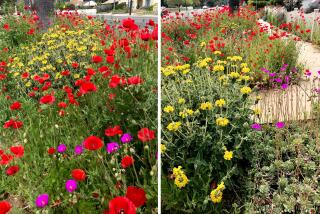GARDENING : Chill: There’s No Need to Tiptoe Around Tulip Beds
- Share via
Although tulips are universally admired, many Orange County gardeners are reluctant to grow them because the flowers have a reputation for being unreliable bloomers in warm climates. But experts say that’s just not so.
“Tulips aren’t a trouble plant if you take the right basic steps,” said Wade Roberts, garden director for Sherman Library & Gardens in Corona del Mar.
“The basic points to remember are that, in warm climates, tulips must be regarded as annuals, and the chilling that they’d normally receive in cold climates has to be replicated by chilling them in refrigerators,” Roberts explained.
What that means is that each year you need to buy new bulbs. You can’t count on the bulbs from last year to bloom again--whether you left them in the ground or went to the trouble to dig them up.
After you buy bulbs, you need to chill them for six weeks before planting. Many tulip growers manage to squeeze them into the kitchen refrigerator; others have a spare fridge just for bulbs.
Bulbs are chilling now for the November planting that will result in the flowering in mid-February through April, depending on weather.
“Tulips add such a special look to the spring garden,” says Cristin Fusano, horticulturist at Rogers Gardens in Corona del Mar. “They’re the icing on the cake; they’re such a gorgeous flower.”
For the past dozen years, Fusano has included them in her own garden in Laguna Beach as well as in landscape designs and gardening classes she teaches.
Dan Davids, co-owner of Davids and Royston, one of the nation’s leading wholesale dealers of bulbs, also dispels the tulip myth.
He plants more than 1,000 tulips each year at his Manhattan Beach residence and swears the task takes him no more than two hours.
Davids’ is the epitome of the minimal-effort approach to tulip planting. Most of his bulbs go into a 4 1/2-by-20-foot bed containing a hedge of Simplicity roses, day lilies and some other permanent plantings. Each fall, using a small electric rototiller, he spends about 20 minutes rototilling the portion of the bed where the tulips are to be added. Because the rose hedge is pink and white, he continues the color pattern with tulips.
“I select white bulbs and throw handfuls across the bed,” he explained. “Then I select the pink bulbs and also throw them across the bed, similar to broadcasting seed for a lawn.”
The final step is when he gets onto his knees in the bed and plants each bulb using a trowel.
Because Davids lives so close to the beach, his soil already contains large amounts of sand. The only amending he does is applying Bandini 101 Soil Builder when he does major plantings in spring or fall.
Although Davids and Royston also sells bulb fertilizer, Davids doesn’t use any in his own garden.
“Frankly, I don’t have the time to place fertilizer at the bottom of each planting hole, and it really isn’t necessary since tulips are annuals in our climate,” he said.
But Fusano and Roberts like to add fertilizer at planting time and recommend the step as added insurance that the flowers will be large and long-lasting.
Horticulturists also say that “bulbs can’t swim” and, because fast-draining soil is crucial to preventing bulb rot, Fusano and Roberts recommend adding sharp sand to the planting bed or container.
Here are their tips for success with tulips:
* Chill the bulbs for six weeks. Bulbs should be stored in paper bags or special plastic bags with large air holes and placed on refrigerator shelves.
* Plant when air and soil temperature is cool. Thanksgiving is ideal, although Davids plants his tulips at the end of December. Don’t plant on an 80-degree day or when there are Santa Ana winds.
* If your soil is clay, amend the planting bed by removing the top 16 inches of soil, breaking up the hardpan and backfilling with soil to which large quantities of amendment have been added. Add a one-inch layer of sand, a handful of bulb booster if desired, then the bulbs. Carefully cover with the rest of the amended soil. If the soil is sandy loam, you can eliminate adding sand.
* Successful tulip displays are achieved by massing them. Plant groups of 13 to 15 or more of the same color and variety. The bulbs should be planted close to one another, but not touching.
* For instant garden color, plant bedding plants such as primroses, pansies or alyssum over the bulbs.
* Water weekly, depending on rainfall.
* When foliage emerges, watch for aphids. They can appear if it heats up in December. Use a misting attachment to the hose and wash off the aphids for insect control.
Tulips can also be grown successfully in containers. Follow the steps outlined above, but add one more. Roberts suggests placing the planted container in a cool, dark spot, such as the north side of a house or inside a cool garage. This helps the bulbs develop a strong root structure. When the foliage emerges, gradually move the container into sun, exposing it to increasing hours of sun over the period of a few days.
Tulips need full or bright sun to flower well. Although gardeners in hot, inland parts of Orange County are cautioned to protect many sun-loving plants with at least some shade, this isn’t necessary with tulips as they flower in February or March, when the sun isn’t as fierce.
Even though a tulip only flowers for a week or so, not all bulbs flower at once. Planting a mix of hybrid tulips that bloom early or late stretches the season.
“You can easily get up to six weeks of bloom from tulips,” Fusano said.
After planting and enjoying thousands of tulips during the past decade, Fusano says she still gets excited about their annual display.
“There’s nothing like tulips,” she says.
Dutch Passion Cultivated the National Symbol
For centuries, people have lost their heads, literally and figuratively, over tulips.
Centuries ago, fortunes were made, lost and made again over these lofty, graceful, colorful flowers. The tall-stemmed beauty is considered by many to be queen of the spring garden. The Dutch are particularly known for their love affair with tulips, and this fall they are inaugurating a yearlong celebration to commemorate the 400th anniversary of the Dutch tulip trade.
It started when an elderly botanist named Carolus Clusius planted a handful of tulip bulbs in a small garden at the University of Leiden in the Netherlands in fall, 1593.
The rare flowers’ beauty captivated Dutch merchants and aristocrats and unleashed a buying frenzy.
In their eagerness to obtain the limited quantity of bulbs, prices soared to the modern equivalent of $44,000 per handful.
The market came to a climatic crash in 1637, causing many to lose their fortunes, but the love and lure of tulips continued.
The Dutch weren’t the first, nor are they the last, to experience tulipmania.
As early as the year 1000, the Turks were cultivating tulips, although the plant probably originated in the steppes of western and central Asia.
Tulips were particularly popular in the courts of Suleiman the Magnificent, sultan of the Ottoman Empire from 1520 to 1566, which some historians call the Ottoman’s “Tulip Age.” The Dutch acquired their first bulbs from the Turks in the late 1500s, but two centuries later the Turks imported bulbs from Holland. And a sultan’s love of tulips proved fatal.
In 1730, Sultan Ahmed III was beheaded for crimes that included spending too much money on tulip festivals.
Today, Holland is still the leading supplier of tulips, and most of the bulbs sold in our local nurseries are Dutch grown.
You can enjoy their beauty in your own landscape or in selected public gardens.
Locally, Sherman Library & Gardens in Corona del Mar features showy displays of thousands of spring bulbs, including 1,600 tulips of 20 different varieties.
That’s only a small number of the 3,500 tulip hybrids and species commercially grown in the Netherlands, whose tulips still dominate the world market.
O.C. Tulip Varieties
According to tulip wholesaler Dan Davids, all tulip varieties sold in Orange County nurseries have been proved in trials to perform well in this region. Davids and horticulturist Cristin Fusano list the following as their favorites:
* Angelique--light pink, double
* Asta Nielsen--yellow
* Ballade--lavender with white, lily flowering
* Blue Heron--soft lavender, fringed
* Blue Jay--violet blue
* Burgundy Lace--wine red, fringed
* Carmel--rose pink
* Estella Rynveld--red and white bi-color, ‘parrot’
* Fantasy--salmon pink with green markings, ‘parrot’
* Georgette-yellow with red edge, multi-flowering
* Jacqueline--pink, lily flowering
* Halcro--red rose
* Hermosa--bright pink
* High Sierra--tall, white
* Hocus Pocus--yellow-tipped pink
* Marina--lavender with white edges
* Maureen--white
* Menton--rose pink
* Orange Favorite--bronze orange with green, ‘parrot’
* Perestroika--salmon/yellow






